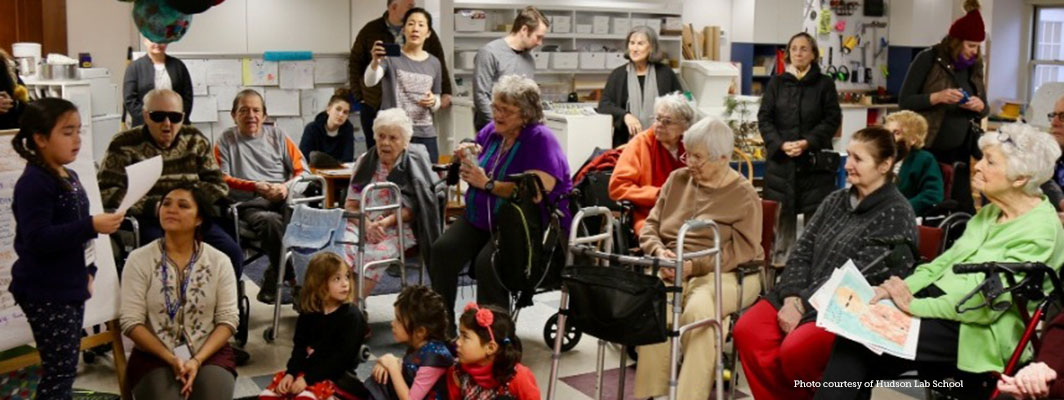
Hudson Lab School is a progressive, project-based K–12 school, set within the skilled nursing home Andrus on Hudson situated on a 26-acre campus. We combine an indoor/outdoor classroom approach with intergenerational programming, providing a unique environment for our students to build community with the “Grands” (what we call the senior residents at Andrus) and staff.
We start with empathy. Before my students meet with any Grands, we’ll discuss some possible challenges Grands may be experiencing and think about what it’s like to live with physical challenges that can complicate seemingly simple tasks. We’ll role-play scenarios like having a conversation with someone with hearing loss; my students then learn to speak loudly, clearly, and slowly without sounding patronizing. We’ll talk about fear of falling from a high branch on a tree and relate that to Grands who may worry about falling while walking down the hallway. As a result, my kids will often remind one another to slow down so that Grands will feel comfortable walking in the hallway.
Our intergenerational program involves a few different types of interactions, both formal and informal, which are the culmination of a lot of team-building and teamwork. We have weekly events like intergenerational library times, which allow Grands and kids to bond over their shared love of reading books and storytelling. We also have sporadic events where Grands will come visit our classroom or we’ll visit their floors, annual gatherings like the intergenerational pancake breakfast with syrup that comes from our sugar maple tree tappings, and an annual student project that focuses on our community at Andrus. The beauty of these interactions is the real friendships that have grown among students and Grands over time.
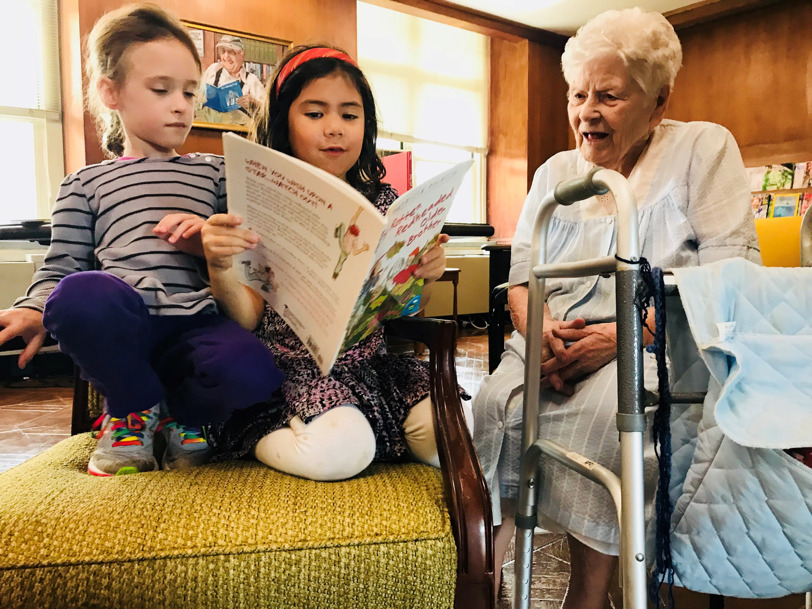
Students read with one of the Grands. Credit: Hudson Lab School.
Our sporadic interactions are sometimes the most memorable, like the time a resident visited our classroom on Veterans Day. He talked about his military service and taught the class how to march.
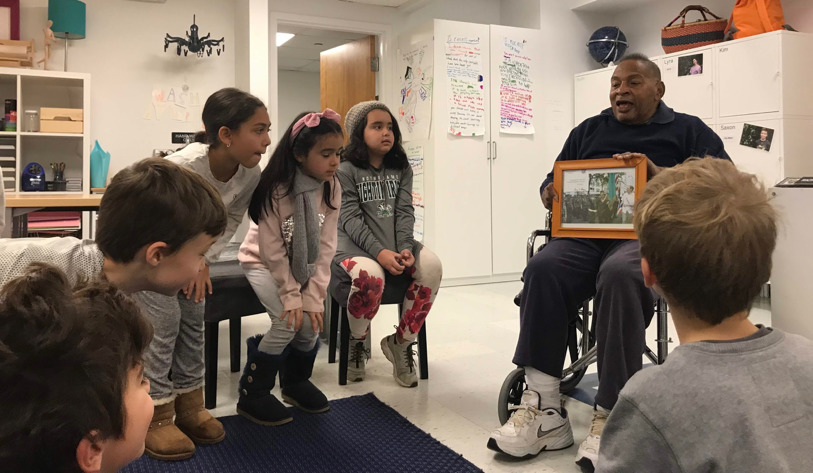
Students learn from a veteran. Credit: Hudson Lab School
There was also the time when a resident showed students photos of the Titanic and relayed the story of his own grandparents who were on the Titanic for that fateful journey. His grandmother was saved on one of the rescue boats, but his grandfather, a famous author, was last seen on the deck lighting up a cigar. These sorts of interactions create vivid memories and bring so much value to everyone involved.
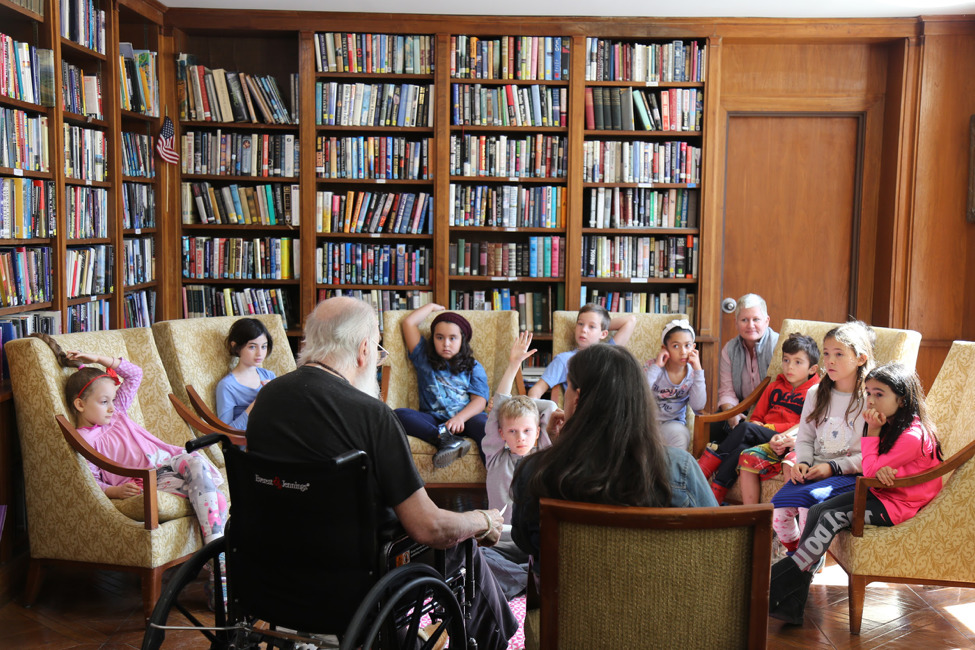
Students in the library with a Grand. Credit: Hudson Lab School
Some of our deepest learning and greatest fulfillment comes from projects that focus on service to our community. Last year, our winter project challenged students to design simple solutions to help improve the lives of the Grands. As part of the design thinking process, our students interviewed physical therapists and speech therapists to understand the difficulties some Grands experience with things like walking, writing, or swallowing liquids. It was fascinating to see the students build connections between things they were focusing on such as handwriting or memorizing times tables, to the challenges of growing older such as reduced fine motor functions or experiencing memory loss. To be honest, it was eye-opening for all of us. Not only did this project teach us greater empathy for the Grands, it really brought the school and the nursing home together as a community with a shared goal.
Hudson Lab School Winter Exhibition 2018
How the elementary students at Hudson Lab School applied #DesignThinking to improve the lives of senior citizens at Andrus on Hudson and the people who care for them.
Posted by Hudson Lab School on Wednesday, March 14, 2018
One of my favorite projects this year was our Nature Nook. My students are outside every day, rain or shine, and have a very special connection to the land. Based on their love of nature, my students wanted to share their enjoyment of the great outdoors with Grands who might not be able to venture outside much, so I challenged them to use the intersection of science, technology, and design to facilitate a relationship between the Andrus community and the surrounding 26 acres in a way that creates equal access for all.
I often use the Stanford d.school’s Design Thinking Process as the framework to organize our process, and the first step is to empathize and understand the user. As a class, we thought about what “equal access” really means for us all, and more specifically, for the Grands. We met with the physical therapy department to better understand accessibility, which led to a study of the American Disabilities Act. We used the design process in a mini-prototype challenge to create doll-sized wheelchairs and walkers, moving through the ideating, prototyping, testing, and refining stages and ultimately brought the final products to the nursery school next door.
What my students knew innately is that nature is good for you! That led us to the study of biophilia and biophilic design. Our building lacks nature indoors (even though the property outside is stunning) so we began to think about how we might change that. We studied our building and its air quality by placing small sensors throughout the space, and we looked at the relationship between trees, plants, and good air quality to figure out where we might have a positive impact. Based on all of our research, we settled on a location in the lobby that seemed viable for us to create an “indoor oasis,” bringing the nature of our campus inside the building. The students built a scaled table model of the property to include in the space so that the Grands would have a 3D map of the property, and created a plan for how they wanted to redesign the space using biophilic design principles.
As part of a broader community, we know that changes require stakeholder buy-in, so we then had to approach the Andrus executive team to persuade them to allow us to redesign the space. The students put together a presentation to pitch their idea using persuasive techniques and backed it all up with research and the model of Andrus on Hudson.
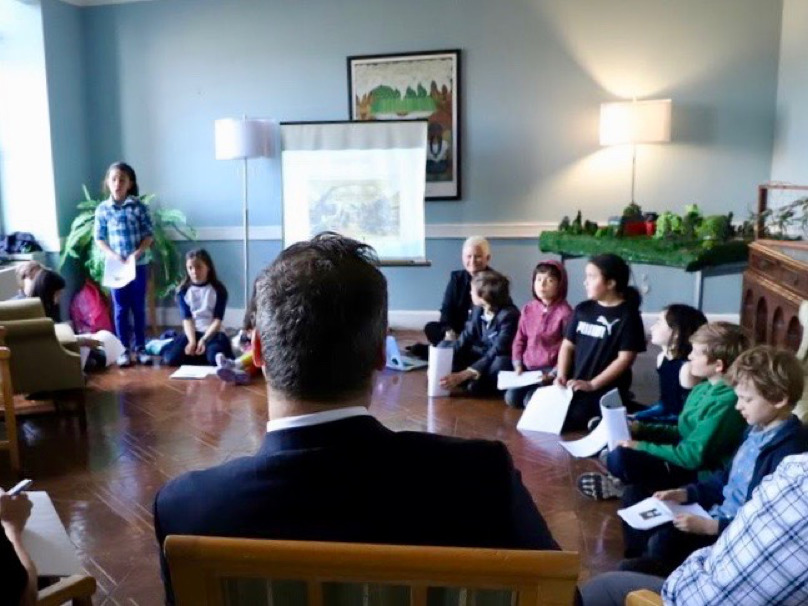
Students pitch their idea. Credit: Hudson Lab School.
The students’ pitch was well-received and approved. However, we still faced the challenge of how this would be financed. We decided to fundraise the money ourselves. We had a Skype call with an entrepreneur who was one of the first to create a crowdfunding site and based on his advice, we set up a GoFundMe page. The students supplemented their online fundraising with two local pop-up shops and they far exceeded their goal of raising $4,000!
My class built an oasis for the Grands and staff of Andrus. It has only been a few weeks since our ribbon cutting, but already we’ve heard countless stories of Grands and Andrus staff seeking out the Nature Nook as a place of restorative peace and serenity. This real-world application for an authentic audience elevated the quality of our students’ work. Not only that, my students learned to manage their time, meet deadlines, design a large-scale project, and bring it to fruition. As I told my students, “You’re change agents, even if you don’t feel like it yet.”
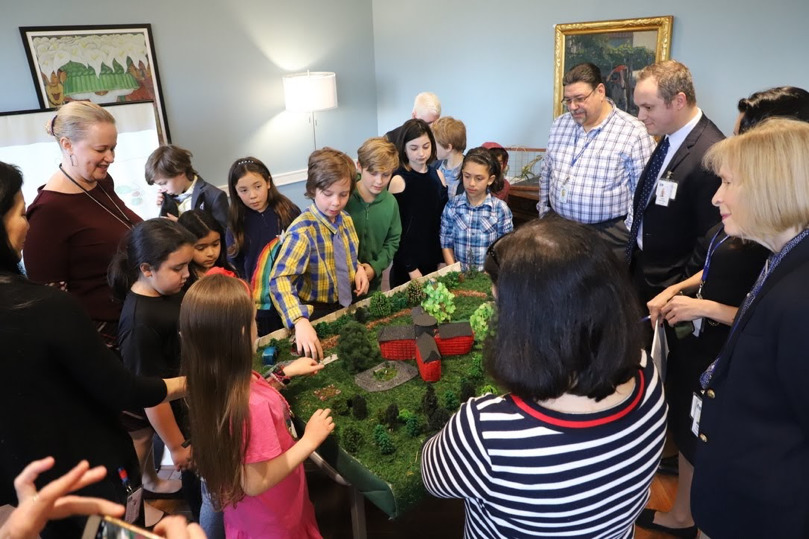
Students with their 3D design of the Andrus on Hudson campus. Credit: Hudson Lab School.
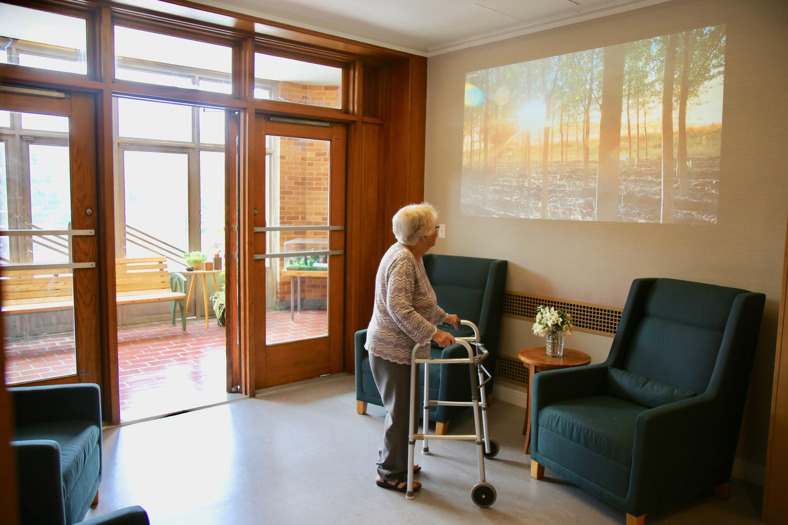
A Grand in the nature nook. Credit: Hudson Lab School.
Hudson Lab School is a unique setting where intergenerational learning is woven into the fabric of their instructional program, but many schools across the country are beginning to explore the value of such an approach, with everything from retirement home partnerships to service learning projects. For educators looking to get started, Kim advises, “Build a relationship, and then the projects will come, and they will be much more enjoyable and natural than if you put people in a room just to get something done.”